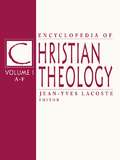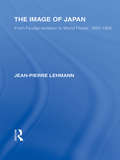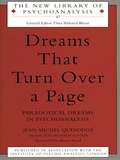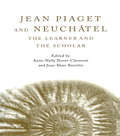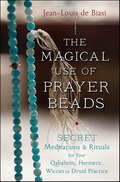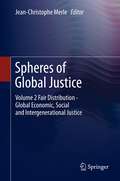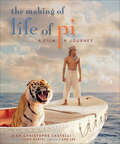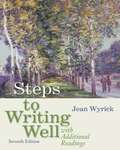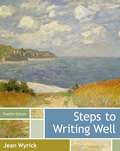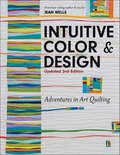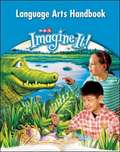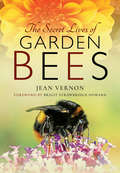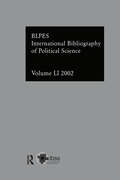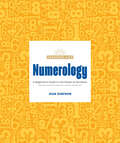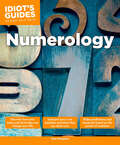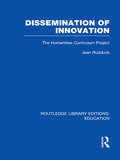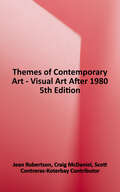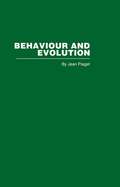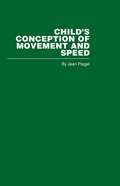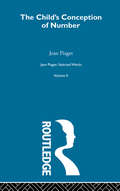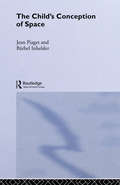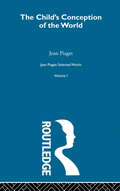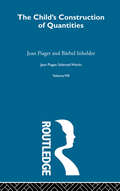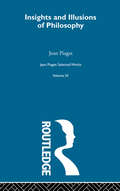- Table View
- List View
Encyclopedia of Christian Theology: 3-volume set
by Jean-Yves LacosteThe Encyclopedia of Christian Theology, translated from the French Dictionnaire Critique de Théologie 2nd Edition, features over 530 entries, contributed by 250 scholars from fifthteen different countries. Alphabetically arranged entries provide the reader a critical overview of the main theological questions and related topics, including concepts, events, councils, theologians, philosophers, movements, and more.Hailed as a "masterpiece of scholarship," this reference work will be of great interest and use for scholars, students of religion and theology as well as general readers.
The Image of Japan: From Feudal Isolation to World Power 1850-1905 (Routledge Library Editions: Japan)
by Jean-Pierre LehmannJapan's image has experienced numerous transmutations. The book covers the metamorphosis from Japan's image of a feudal, exotic and romantic land inhabited by Madam Butterflies, to its sudden emergence as a geopolitical power following its defeat of Russia in 1905. More was to come. In the 1930s and 40s the image of the kamikaze vividly illustrated the fanaticism and barbarity associated with Japan in World War II. With the 1964 Tokyo Olympics, Japan rejoined the international community as a friend and ally of the US. The next transmutation came in the 1980s when the Japanese economy appeared to be functioning on anabolic steroids and its continued ascent to take over the US was predicted. "Japanese management" became more than a science, almost a religion, among business schools and consultancies. Today there are two images: one is conveyed through manga, karaoke and the global fashion for sushi; the other is of an economically and demographically declining nation. Will this image correspond to Japan's swan song or are there more transmutations on the way? One constant in Japanese history and the image it has projected has been the country's constant ability to surprise.
Dreams That Turn Over a Page: Paradoxical Dreams in Psychoanalysis (The New Library of Psychoanalysis #Vol. 43)
by Jean-Michel QuinodozWinner of the 2010 Sigourney Award! In Dreams That Turn Over a Page, the author discusses a particular type of dream that comes after a phase in analysis where integration has taken place. Accompanied by anxiety and fear, which seem surprising as the dream follows a phase of integrative work in the analysis, these dreams are in fact a mark of progression as they indicate a capacity to own anxiety. Quinodoz describes the important technical implications of this understanding, suggesting that it is essential to interpret to the patient that the anxiety indicates not a regression, but a shift in the opposite direction. In addition to the theory and discussion of the literature, he gives many clinical examples of such dreams from patients in psychoanalysis to illustrate the concepts of dreams that turn over a page. As Freud's classical theory of dreams does not by itself suffice to interpret or explain the formation of these particular dreams, Quinodoz invokes contemporary ideas to understand the underlying transformations which bring the 'return' of split-off parts of the self during the phases of integration. The author considers the reasons why dreams that mark this transition have a more powerful impact than others on both patient and analyst, and observes similarities between the clinical impact of such a dream and the aesthetic impact of a work of art.
Jean Piaget and Neuchâtel: The Learner and the Scholar
by Anne-Nelly Perret-Clermont Jean-Marc BarreletJean Piaget is widely acknowledged as one of the most important scholars of the twentieth century. His passionate philosophical search for an understanding of the nature of knowledge led him to make major contributions to the study of child development and epistemology. But how did his early life in Neuchâtel inspire him to embark on this search? Taking a socio-historical and cultural perspective, this book outlines the development of Piaget's understanding of major issues regarding mind, faith, science, logic, peace, and social rights in a time of anxiety. and world wars The international and multidisciplinary contributors investigate Piaget the adolescent as he begins his quest for autonomy of reason and sets out to create his own explanatory system for cognitive growth. The latter part of the book goes on to consider the early reception of Piaget's work in different cultural contexts and his impact on issues of psychology and educational reform. Piaget's theoretical system can be seen as an expression of the values he developed during his childhood and adolescence as he searched for the conditions of reciprocal relationships and rational dialogues. Jean Piaget and Neuchâtel demonstrates that in today's climate, the questions Piaget addressed remain very relevant and invite new enquiries from different standpoints. This book will therefore be of interest to psychologists, educators, and philosophers. This book is published with the support of Pro Helvetia, Swiss Arts Council.
The Magical Use of Prayer Beads: Secret Meditations & Rituals for Your Qabalistic, Hermetic, Wiccan or Druid Practice
by Jean-Louis de BiasiJoin author Jean-Louis de Biasi as he explores how the profound tactile experience of using prayer beads can be used to deepen spiritual work in Qabala, Wicca, Druidry, and Hermetic traditions. With tips and techniques for choosing prayer beads as well as cleansing and consecrating them for spiritual use, The Magical Use of Prayer Beads is an ideal guide for beginners and adepts alike. Includes rituals that can be performed alone, with two people, or with a group—extending the useful applications and power beyond the more traditional approaches. This book explores unique practices for some of the most prominent Western mystery traditions, creating new paths on the journey of spirituality and magic.
Spheres of Global Justice: Volume 1 Global Challenges to Liberal Democracy. Political Participation, Minorities and Migrations; Volume 2 Fair Distribution - Global Economic, Social and Intergenerational Justice
by Jean-Christophe MerleSpheres of Global Justice analyzes six of the most important and controversial spheres of global justice, each concerning a specific global social good. These spheres are democratic participation, migrations, cultural minorities, economic justice, social justice, and intergenerational justice. Together they constitute two constellations dealt with, in this collection of essays by leading scholars, in two different volumes: Global Challenges to Liberal Democracy and Fair Distribution. These essays illustrate each of the spheres, delving into their differences, commonalities, collisions and interconnections. Unlike many writings on global justice, Spheres of Global Justice does not content itself with describing the painful and advantageous effects of the globalization process as being ipso facto a global injustice or a just global order. Rather, this multidisciplinary collection of essays, from a pluralist inspiration, combines empirical analysis with theoretical approaches and ethical principles, paying close attention to two aspects of the effects of the globalization process. These aspects are the causal relationships that lead to such effects and the kinds of obligations, or of normative relationships between global rights and correlative duties, that applies to each specific individual case. This volume illustrates how diverse global obligations are, and how they can be, grounded in diverse relationships (identity, ability to provide help, causal responsibility, past injustices, protection of agency and promotion of independence, etc.). These essays also demonstrate that an ethical global approach has not only international or transnational, but also domestic, local and interpersonal dimensions.
The Making of Life of Pi: A Film, a Journey
by Jean-Christophe CastelliDiversely illustrated with 275 photographs and illustrations, The Making of Life of Pi tells the inside story of how renowned Academy Award-winning director Ang Lee brought Yann Martel's international bestseller to life as a 3-D film.With a rich, entertaining text and a wide variety of facts, anecdotes, visual portfolios, and sidebars sure to delight readers of all ages, The Making of Life of Pi follows the making of the film from pre-production through final cut. Of course, you'll meet Suraj Sharma, the sixteen-year-old unknown Indian high-school student who won the part of Pi although he had no acting experience and didn't even know how to swim—yet in the end performed all of his own stunts. You'll learn about the massive wave tank, custom-built for the film that replicated a vast, stormy ocean in all its moods, thanks to a complex and specially devised menu of wave and wind combinations, some really powerful machinery, and tons of water. You'll get to look inside the fifty-page fully illustrated "survival guide" that shipwreck survivor Steven Callahan created for Pi to consult on his raft. And you'll read about King, Themis, Minh, and Jonas, the four Bengal tigers used in the film—and discover how visual effects were able to create a seamless 3-D image of the tiger Richard Parker.A foreword by Yann Martel, an introduction by Ang Lee, and an incredible range of visual materials—fine art, vintage archival imagery, and commissioned portfolios by photographer Mary Ellen Mark and artist Alexis Rockman—supplement the film's storyboards, sketches, and stills, rounding out this highly experiential book for lovers of the novel and film viewers alike.
Steps to Writing Well with Additional Readings (7th edition)
by Jean WyrickWriting well is just a step away! Join the thousands of students who have learned to write well with Jean Wyrick's helpful instructions. STEPS TO WRITING WELL WITH ADDITIONAL READINGS, Seventh Edition, is the ultimate step-by-step guide to writing effective essays. With Wyrick's clear, practical advice and student-friendly tone, you'll find it easy to begin, organize, and revise your writing-from choosing a topic to developing your essay to polishing your prose. Interesting readings in a variety of styles offer useful examples of the types of essays you'll most often be assigned in your composition and other college classes.
Steps to Writing Well, Twelfth Edition
by Jean WyrickReliable and straightforward, this text has helped thousands of students learn to write well. Jean Wyrick's rhetorically organized STEPS TO WRITING WELL is known for its student-friendly tone and the clear way it presents the basics of essay writing in an easy-to-follow progression of useful lessons and activities. Through straightforward advice and thoughtful assignments, the text gives students the practice they need to approach writing well-constructed essays with confidence. With Wyrick's helpful instruction and the book's professional samples by both well-known classic and contemporary writers, STEPS TO WRITING WELL sets students on a solid path to writing success. Everything students need to begin, organize, and revise writing--from choosing a topic to developing the essay to polishing prose--is right here! In the twelfth edition, Wyrick updates and refines the book's successful approach, adding useful new discussions, readings, exercises, essay assignments, and visual images for analysis.
Intuitive Color & Design: Adventures in Art Quilting
by Jean WellsThink outside the block and look what happens! Jean Wells gives you the assignment of your life: put away your ruler and use your inner vision to design and piece spectacular, free-form quilts you'd never have guessed you could create. In this updated edition of best-selling Intuitive Color & Design, Jean’s workshop assignments get your creative juices flowing, giving you challenges to expand your quilting horizons. Start by learning to see line and color; study the nuts and bolts of design; develop your color work and composition; and when you get stuck, there’s expert advice on problem solving. You will never see quiltmaking in the same way again. • Creative exercises take your use of color, line, design, and piecing in dramatic new directions • Use photographs and journals to find inspiration and develop your ideas with Jean’s updated, expert guidance • Learn innovative finishing techniques to show your quilts at their best • Classroom-proven techniques make the adventure easy for any quilter
SRA: Imagine It! Language Arts Handbook, Level 3 [Grade 3]
by Jean Wallace Gillet Charles Temple James D. WilliamsNIMAC-sourced textbook
The Secret Lives of Garden Bees
by Jean VernonA friendly, accessible guide into the weird, but wonderful world of bees in the gardens of the UK.From the common or garden bumblebees that nest in bird boxes, compost heaps, and old mouse holes making “Winnie the Pooh” style honey pots to feed their babes; to the quirky wool carder bee, a solitary bee that combs the fluff from garden plants to line her brood cells; and the amazing leaf cutter bee that carves chunks out of plant foliage to seal its egg chambers . . .This book will reveal the secrets and fascinating lives of the bees that live and breed in your garden, from buzz pollination, to the bee robbers that cheat the plants and steal nectar by stealth.With a chapter per season to explore what you are likely to see in your garden, great plants to grow to help them, plus other fascinating information on these secretive creatures, this book is designed to bring alive the world of garden before your very eyes.“The colorful narrative radiates the authors love for bees and is punctuated with heaps of beautiful photographs. Easily read from cover to cover or dipped in to when in need of bee identification.” —Sunday Express (UK)
IBSS: Political Science: 2002 Vol.51
by Jean SykesFirst published in 1952, the International Bibliography of the Social Sciences (anthropology, economics, political science, and sociology) is well established as a major bibliographic reference for students, researchers and librarians in the social sciences worldwide. Key features * Authority : rigorous standards are applied to make the IBSS the most authoritative selective bibliography ever produced. Articles and books are selected on merit by some of the world's most expert librarians and academics. * Breadth : today the IBSS covers over 2000 journals - more than any other comparable resource. The latest monograph publications are also included. * International Coverage : the IBSS reviews scholarship published in over 30 languages, including publications from Eastern Europe and the developing world. * User friendly organization : all non-English titles are word sections. Extensive author, subject and place name indexes are provided in both English and French. Place your standing order now for the 2002 volumes of the the IBSS Anthropology : 2002 Vol.48 December 2002: 234x156: 0-415-32634-6: u195.00 Economics : 2002 Vol.51 December 2002: 234x156: 0-415-32635-4: u195.0 0 Political Science : 2002 Vol.51 December 2002: 234x156: 0-415-32636-2: u195.00 Sociology : 2002 Vol.52 December 2002: 234x156: 0-415-32637-0: u195.00
Numerology: A Beginner's Guide to the Power of Numbers
by Jean SimpsonWidespread interest in numerology never seems to wane, but there are still plenty of people who want to know how to use numbers to learn more about themselves and to make predictions for the future. Idiot's Guides: Numerology is an easy-to-understand reference that explains Chaldean, Pythagorean, Kabbalah, Chinese, and other systems. It offers step-by-step instructions for calculating and interpreting the various types of numbers, including the Destiny, Soul, Personality, and Life Path numbers, as well Pinnacles and Challenges. Idiot's Guides: Numerology also includes a succinct, but detailed, worksheet for calculating and capturing all of the various personal numbers.
Numerology: Make Predictions and Decisions Based on the Power of Numbers (Idiot's Guides)
by Jean SimpsonWidespread interest in numerology never seems to wane, but there are still plenty of people who want to know how to use numbers to learn more about themselves and to make predictions for the future. Idiot's Guides: Numerology is an easy-to-understand reference that explains Chaldean, Pythagorean, Kabbalah, Chinese, and other systems. It offers step-by-step instructions for calculating and interpreting the various types of numbers, including the Destiny, Soul, Personality, and Life Path numbers, as well Pinnacles and Challenges. Idiot's Guides: Numerology also includes a succinct, but detailed, worksheet for calculating and capturing all of the various personal numbers.
Get the Best Out of the Rest of Your Life: A Woman's Guide to the Second Half of Life
by Jean Shapiro[from inside flaps] "This book explodes the myth that once we reach our middle years life is all downhill. Drawing on her experience as an agony aunt, Jean Shapiro answers the real questions women have put to her, covering subjects like health, relationships, sex, loneliness and planning a positive future. From remarriage to coping with financial crises, Get The Best Out Of The Rest Of Your Life is packed with useful and confidence-building advice. Readers will find they are not 'over the hill' but within reach of new summits."
Dissemination of Innovation: The Humanities Curriculum Project (Routledge Library Editions: Education)
by Jean RudduckThis volume of topical working papers makes available to teachers and to others information intended to stimulate discussion so that all educators may bring their judgement and experience to bear on the concerns of the School Council and contribute to its work. The papers describe plans for curriculum development projects at their formative stages, when comment can be particularly helpful; report on conferences and summarize findings and opinions on debated questions about the curriculum and examination in schools.
Themes of Contemporary Art: Visual Art After 1980, 5th Edition
by Jean Robertson Craig McDanielThis book offers students and readers an introduction to recent art. The primary focus is an examination of themes that are widespread in contemporary artistic practice. Individual chapters analyze thematic content in eight groupings: Identity, The Body, Time, Memory, Place, Language, Science, and Spirituality. These eight thematic categories provide a significant sample from which readers can grasp influential concepts that stretch across much of the art of our time. Profiles of key artists and works enhance students' understanding of these major themes and the individual approaches and key movements in the world of contemporary art.
Child's Conception of Number: Selected Works vol 2
by Jean PiagetFirst published in 1997. This is Volume II of selected works of Jean Piaget which looks at his thinking on children and how their interaction and perception of number, touching on the areas of development in thinking on conversation of quantities and invariance of wholes; cardinal and ordinal one-one correspondence; as well as additive and multicatitive compositions. These explorations look into tracing the development of the operations which give rise to number and continuous quantities, to space, time, speed, etc., operations which, in these essential fields, lead from intuitive and egocentric pre-logic to rational co-ordination that is both deductive and inductive.
Child's Conception of Space: Selected Works vol 4 (International Library Of Philosophy, Psychology, And Scientific Method)
by Jean PiagetFirst published in 1997. Routledge is an imprint of Taylor & Francis, an informa company.
Child's Conception of the World: Selected Works vol 1 (Quality Paperback Ser.)
by Jean PiagetFirst published in 1997. This is Volume I of selected works of Jean Piaget which looks at his thinking on children perceive the world around them, touching on his concepts of realism, animism and artificialism.
Child's Construction of Quantities: Selected Works vol 8
by Jean PiagetFirst published in 1974. Routledge is an imprint of Taylor & Francis, an informa company.
Insights and Illusions of Philosophy: Selected Works vol 9
by Jean PiagetFirst published in 1997. Routledge is an imprint of Taylor & Francis, an informa company.
